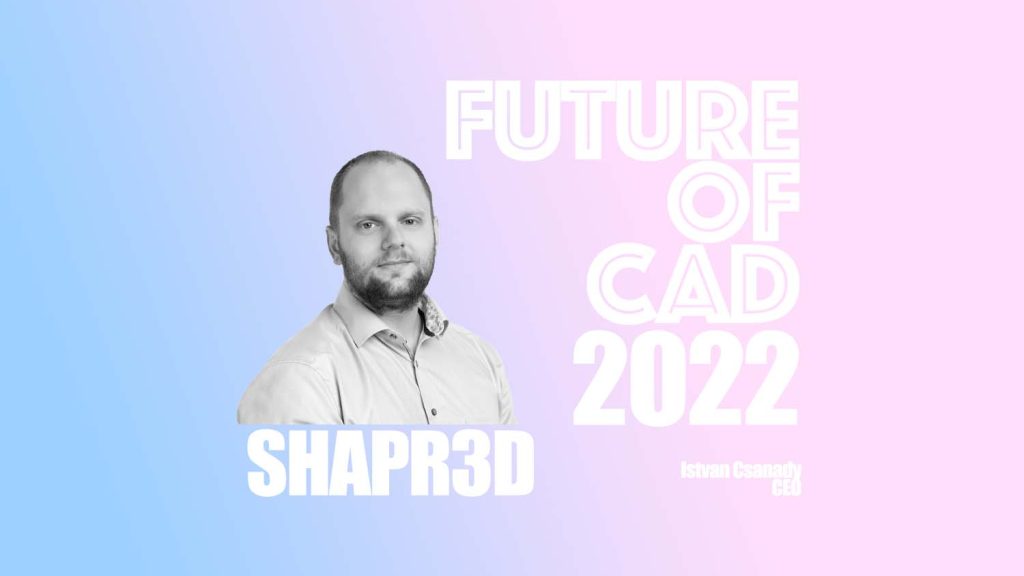 Future of CAD – Shapr3D
Future of CAD – Shapr3D
Time stands still for no-one – including design software, so we asked Istvan Csanady, CEO Shapr3D, for their opinions on the direction of CAD, ranging from initial concepting workflows, the impact of Artificial Intelligence (AI), and even how we keep it up to date
Q
How do you imagine sketch tool environments evolving?
I believe AR and VR will gain a significant market share, not just for sketching but for CAD in general – the only question is when. We are still waiting for the first proper VR and/or AR platform that isn’t just a gimmick or a content consumption device, but a proper workhorse. Once we have that, these tools should rapidly gain popularity.
Q
How do you imagine designers will interact with CAD UIs in the future?
You are asking this question to the CEO of the fastest growing CAD company that started as an iPad-only application. Although Shapr3D is now available on Windows tablets and PCs, and macOS and iPadOS, certainly one of our most popular features is our revolutionary touch-and-stylus user interface.
Touch and stylus is a more natural and often faster way to use a CAD system than a keyboard and a mouse. The only thing that could be even more natural is a well-designed AR or VR experience, which is something that still belongs to the future.
Q
Downloading regular updates to a 3D CAD package is more common – is this the way all 3D CAD is now heading?
Annual releases are a thing of the past. In the last 30 years, software development evolved a lot and modern software companies like Shapr3D are able to reliably ship new features every two weeks thanks to our large, automated test suite and continuous-integration implementation. Even the pain of installing updates is gone: modern operating systems provide seamless ways to automatically upgrade software without needing to fear broken dependencies or missing DLLs.
It’s quite unfortunate that this is something that we still need to talk about in the CAD industry: legacy companies have evidently been great at training CAD users to endure painful upgrades. Shapr3D users never face any issues like that.
There is this common perception in the CAD industry that ‘CAD must be some kind of special beast’, and that’s why it’s so clumsy and fragile, but the truth is that CAD is just a piece of software like any other software.
It doesn’t need to be clumsy and fragile—it’s only like that because legacy CAD companies are building software like they did in the 1990’s, and their customers are suffering from those obsolete practices. It’s time to change that.
Q
How do you view the increase in AI impacting design tools the most?
It’s hard to tell at this point in time because AI is one of the most rapidly-evolving areas of computer science. Use cases that were completely unprecedented are popping up every day.
One of my favorites is how DALL-E can help create better conceptual designs. I see AI as an enabler and not a replacer of humans, and I’m very excited about what the future holds. I believe that AI will enable us to design things that we weren’t able to design before, and I believe that AI will make engineering and design more efficient and more powerful in ways that are impossible to foresee right now.
Q
How do you imagine the users of your software will change and how do you see this impacting the software?
One of the most powerful aspects of Shapr3D is how we opened up design and engineering to the world. Our tens of thousands of customers are mostly professional engineers and designers, but we have plenty of customers who are completely new to the world of manufacturing and design.
I believe that making design more accessible will have a dramatic impact on how we design: one of our Fortune 500 customers, for example, is using Shapr3D to make the design process more inclusive across the company because it enables more stakeholders to easily contribute to the design process, so they can make better decisions faster.
I believe that accessing CAD will not be a privilege of a small, highly trained group of engineers, but it will become a tool that all stakeholders can access. For designing, reviewing, conceptualizing, collaborating, prototyping, and manufacturing – all stakeholders will be able to use the same design platform in the future.
New generations of CAD users expect their software to be accessible across different devices: they want an equally great mobile and desktop experience. Consumer-grade usability and accessibility of software is a basic expectation, not just a gimmick. Legacy CAD companies are having a tough time adapting to this tectonic shift in customer expectations.
Q
When will CAD software be able to take advantage of modern graphics APIs for better 3D performance and advanced features like GPU ray tracing?
Well, Shapr3D already does and will do even more, but I can’t talk about that just yet!






